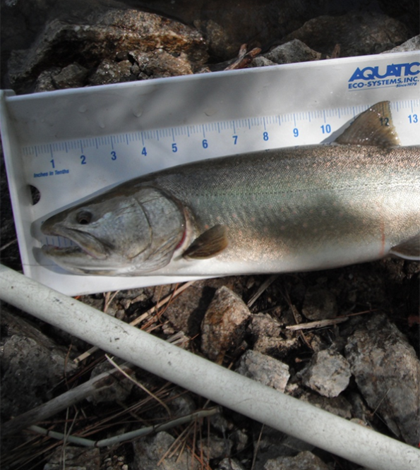Acoustic tags track threatened bull trout in a highly regulated reservoir

A bull trout measured during survey operations on Arrowrock Reservoir (Credit: USGS)
Arrowrock Reservoir, an impoundment on the Boise River in southwestern Idaho, holds one of the southernmost populations of threatened bull trout. Scientists working to conserve the species are interested in where the trout spend their time in the reservoir, especially since the reservoir surrenders an average of 85 percent of its volume to downstream water uses each summer.
“That puts a lot of stress on the fishery,” said Terry Maret, supervisory biologist with the U.S. Geological Survey’s Idaho Water Science Center. “When you take 85 percent of the volume out of a water body, where do the fish go?”
That’s a particularly important question for Arrowrock’s bull trout, an adfluvial population that migrates out of the reservoir in the spring to spawn in cool tributaries. Maret said bull trout have been documented traveling 30 miles or more upstream, a journey that can sap a fish of 25 percent of its body weight.
The U.S. Bureau of Reclamation, which operates the reservoirs along this stretch of the Boise, is charged with developing a better understanding of bull trout habitat use, including where the fish live, move and spawn. The USGS supports them in that mission. A key part of that effort has been tagging fish with radio transmitters that allow researchers to detect the locations of marked fish.
But the radio tags have a shortcoming: They can only transmit a signal through water less than 9 meters deep. Bull trout are known to use deep water, and Arrowrock reaches depths of up to 60 meters when it’s full.
“We have a lot of radio-tagged fish disappear,” Maret said. “They basically go off the radar. A lot of them had to be down in deeper water.”

Arrowrock Reservoir (Credit: USGS)
To get a better idea of how the fish use the reservoir’s deepwater habitat–and learn where the fish go in the summer when the water level plummets–the Bureau of Reclamation and the USGS recently turned to acoustic tags, which don’t suffer the same depth limits as radio tags.
In spring 2012, crews tagged 18 bull trout with acoustic transmitters that also register the fish’s depth and temperature. Their locations were tracked throughout the summer by three receivers installed at fixed locations, as well as weekly mobile tracking surveys with a boat-mounted receiver.
The results show that the fish do indeed take advantage of the reservoirs deeper waters. Fish were detected swimming at depths as low as 24 meters in the water column. The researchers also found that all of the tagged fish had fled the reservoir for the tributaries by early June, leaving before the drawdown began.
That appears to be a smart move on the fishes’ part. Bull trout are among the most temperature-sensitive coldwater species in North America, requiring water temperatures below 15 degrees Celsius. The researchers conducted biweekly profiles of temperature and dissolved oxygen in the reservoir with a multiparameter water quality meter.
“It gives you some idea of how much habitat is available out there that would be favorable to bull trout,” Maret said. “And there wasn’t a lot by August.”

Mobile tracking surveys were conducted weekly with a boat-mounted receiver (Credit: USGS)
Part of the motivation for the acoustic survey was to give the Bureau of Reclamation guidance on how to operate their reservoirs in a way that minimizes habitat loss. The data strongly suggest that the fish leave before the annual drawdown, which could be a sign that their current operations aren’t doing much harm.
The data from this study could come in handy later for researchers looking into how bull trout respond to climate change. The Arrowrock’s bull trout are among the farthest south in the species’ distribution, suggesting they’ll be especially vulnerable to warming temperatures.
“With all the issues of climate change, that’s certainly one species of concern because they do require cold water,” Maret said. “If the climate is warming up, then that species isn’t going to fare very well.”
Top image: A bull trout measured during survey operations on Arrowrock Reservoir (Credit: USGS)





0 comments